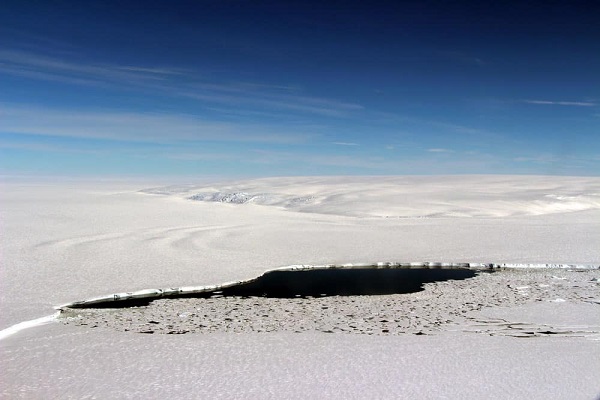Coastal Polynya Variability and Marine-Terminating Glacier Change

A polynya is an area of open water surrounded by sea ice. One of our goals is to understand the interaction between polynya circulation and ice shelves in different dynamical regimes.
This is a newly-funded NSF project working with collaborators Gordon Zhang (WHOI) and Helene Seroussi (Dartmouth). We'd like to understand the variability of Antarctic ice shelf and marine-terminating glacier melt rates with a particular focus on the effects of coastal polynyas (areas of open water amidst sea ice) and how they modify the local oceanographic environment.
To date the relationship between polynyas and ice shelf melt has not been characterized on Antarctic-wide scales. We are going to test four main hypotheses: 1) Variations of coastal polynya extent are correlated with those of the ice shelf melt rates, and this correlation varies around Antarctica; 2) Polynya extent modulates a feedback between ice shelf melt and accretion regimes through stratification of local waters; 3) Polynya extent together with seafloor bathymetry regulate the volume of warm offshore waters that reach ice margins; and 4) The strength of the feedback between polynya and glacier ice varies with geographic setting and influences the long-term stability of the glacial system.
Observational data, (e.g., ice-penetrating radar, radar and laser altimetry, in situ hydrographic data, and derived data sets from the Estimating the Climate and Circulation of the Ocean (ECCO) project and BedMachine Antarctica), will be used in conjunction with ocean (MITgcm) and ice sheet (ISSM) models to reveal underlying dynamics. The models will be coupled, enabling new capabilities focused on ice and ocean co-evolution over time to examine and understand the interaction between polynya circulation and ice shelves in different dynamical regimes.
Our work is complementary/synergistic with several ongoing projects in the area of polynya and ice shelf-ocean interactions, but also differentiates itself in that our research focuses on the spatial variation of polynya-ice shelf two-way interaction on the pan-Antarctic scale rather than solely investigating one location or one component (e.g., ocean or ice). While it has been suggested that specific polynyas have an effect on the neighboring ice sheet, anticipated results from this work will demonstrate whether or not changes in the margins of the Antarctic Ice Sheet can be statistically tied to the surface observable quantity of sea ice extent and polynya size, and how strong and spatially variable that correlation might be around the Antarctic coast over time.
Observations in conjunction with a newly coupled modeling approach will demonstrate how basal melt rate varies with not only the ocean water temperature but also the ocean stratification. This in turn will enable determination of whether dense saline water (DSW) formation not only drives local ocean overturning, but also physically blocks offshore warm water access to the ice shelf cavity. The paired modeling approach, validated against observations, will enable quantification of the influence of the ice shelf geometry (and its variations) on polynya activity around Antarctica. This will also allow us to determine whether there is a quantifiable stability criterion in the balance of i) sea ice structural support and ii) melt-induced thinning (or accretion-induced thickening) in the modulation of ice shelf calving.